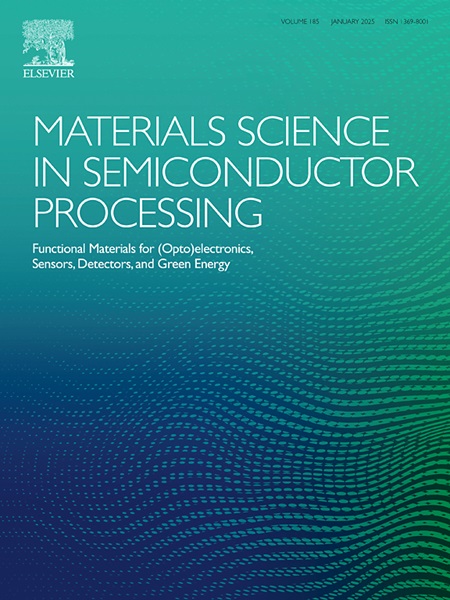Investigations on HfO2/n-GaAs(110) interface, in-situ obtained by Oxide-MBE
IF 4.6
3区 工程技术
Q2 ENGINEERING, ELECTRICAL & ELECTRONIC
引用次数: 0
Abstract
Hafnium oxide (HfO2) thin films were deposited on n-type gallium arsenide (GaAs) substrates by Oxide-Molecular Beam Epitaxy (Oxide-MBE) method using Hafnium (Hf) metallic flow in an oxidizing atmosphere of 10-6 mbar molecular oxygen. The Hf metallic flow was provided by an e-beam evaporator and a deposition rate of ∼ 10 nm/h was established. Semiconductor surface preparation was done prior to deposition, beginning with chemical wet etching and aggressively adjusted by in-situ treatments until a desired stoichiometry was reached. Heterojunctions with HfO2 thin layers of 1 nm, 3 nm, 10 nm and 20 nm were fabricated. X-Ray Photoelectron Spectroscopy (XPS) and ARXPS(Angle Resolved XPS) in-situ analyses provided a clear picture of the structure of the interfaces, the chemical bonds and their composition. The interfaces are chemically stable and abrupt. A small amount of Ga2O3 provides a passivating effect of the semiconductor surface. The electrical properties of the heterostructures were determined using the Kraut method and Reflection Electron Energy Loss Spectroscopy (REELS) technique. Band offsets of ΔEC=1.75 eV and ΔEV=2.62 eV confirm a high application potential. Additionally, data on the morphology and continuity of the layers were obtained by Atomic Force Microscopy (AFM) technique while the amorphous growth was monitored by XRD(X-ray Diffraction), GIXRD (Grazing Incidence XRD) and XRR(X-ray Reflectivity) measurements. The dielectric layers showed values of the constant k in the range of 19-22, established by electrical measurements on MOS type capacitors.
氧化物- mbe原位获得的HfO2/n-GaAs(110)界面研究
采用氧化物-分子束外延(oxide - mbe)方法,在10-6 mbar分子氧氧化气氛下,利用铪(Hf)金属流在n型砷化镓(GaAs)衬底上沉积了氧化铪(HfO2)薄膜。电子束蒸发器提供Hf金属流,沉积速率为~ 10 nm/h。半导体表面制备在沉积之前完成,从化学湿蚀刻开始,通过原位处理进行积极调整,直到达到所需的化学计量。制备了1 nm、3 nm、10 nm和20 nm的HfO2薄层异质结。x射线光电子能谱(XPS)和ARXPS(角度分辨XPS)原位分析提供了界面结构、化学键及其组成的清晰图像。界面具有化学稳定性和突然性。少量的Ga2O3对半导体表面有钝化作用。利用Kraut法和反射电子能量损失谱(REELS)技术测定了异质结构的电学性质。ΔEC=1.75 eV和ΔEV=2.62 eV的频带偏移证实了高的应用潜力。此外,通过原子力显微镜(AFM)技术获得了层的形貌和连续性数据,并通过XRD(x射线衍射),GIXRD(掠入射XRD)和XRR(x射线反射率)测量监测了非晶态生长。电介质层的常数k值在19-22之间,这是通过对MOS型电容器的电测量得到的。
本文章由计算机程序翻译,如有差异,请以英文原文为准。
求助全文
约1分钟内获得全文
求助全文
来源期刊

Materials Science in Semiconductor Processing
工程技术-材料科学:综合
CiteScore
8.00
自引率
4.90%
发文量
780
审稿时长
42 days
期刊介绍:
Materials Science in Semiconductor Processing provides a unique forum for the discussion of novel processing, applications and theoretical studies of functional materials and devices for (opto)electronics, sensors, detectors, biotechnology and green energy.
Each issue will aim to provide a snapshot of current insights, new achievements, breakthroughs and future trends in such diverse fields as microelectronics, energy conversion and storage, communications, biotechnology, (photo)catalysis, nano- and thin-film technology, hybrid and composite materials, chemical processing, vapor-phase deposition, device fabrication, and modelling, which are the backbone of advanced semiconductor processing and applications.
Coverage will include: advanced lithography for submicron devices; etching and related topics; ion implantation; damage evolution and related issues; plasma and thermal CVD; rapid thermal processing; advanced metallization and interconnect schemes; thin dielectric layers, oxidation; sol-gel processing; chemical bath and (electro)chemical deposition; compound semiconductor processing; new non-oxide materials and their applications; (macro)molecular and hybrid materials; molecular dynamics, ab-initio methods, Monte Carlo, etc.; new materials and processes for discrete and integrated circuits; magnetic materials and spintronics; heterostructures and quantum devices; engineering of the electrical and optical properties of semiconductors; crystal growth mechanisms; reliability, defect density, intrinsic impurities and defects.
 求助内容:
求助内容: 应助结果提醒方式:
应助结果提醒方式:


